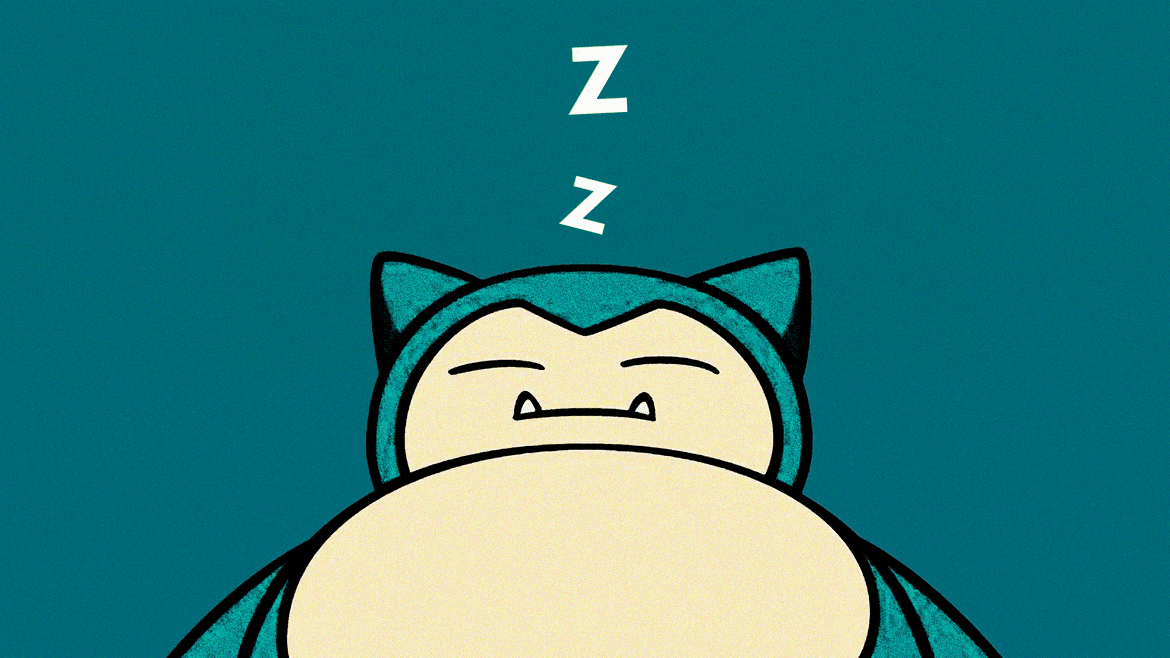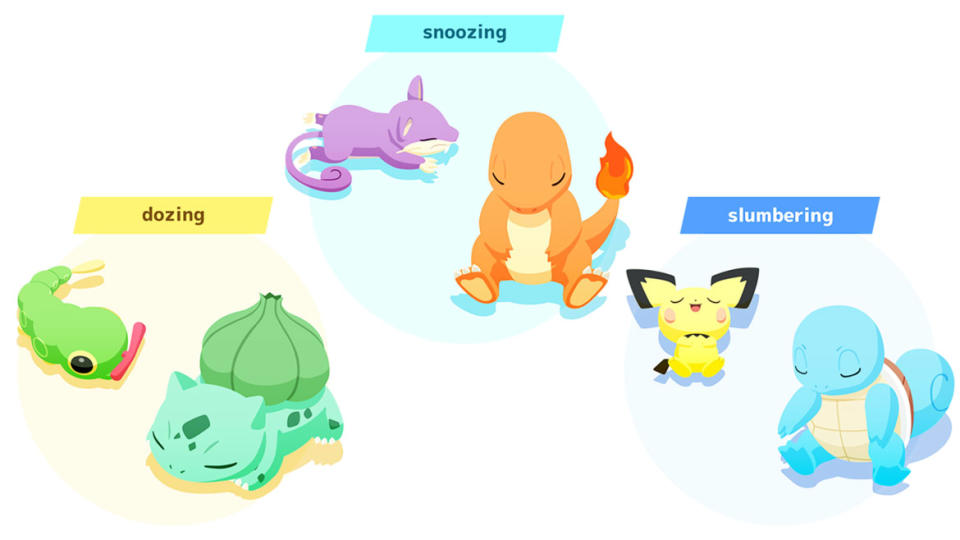How Pokémon Sleep Monetizes Your Unconscious Mind

I’ve always considered myself to be a terrible sleeper, and now I have some adorable proof. Despite staying unconscious for what I believed to be a satisfying, even impressive eight hours and 37 minutes—in a cozy hotel room, provided by The Pokémon Company—I woke up to find that Pokémon Sleep had deemed my sleep subpar.
Pokémon Sleep is the functional opposite of Pokémon Go, as I learned during an overnight preview event ahead of the mobile game’s release. I use “game” lightly; the latest iteration of the Pokémon brand is more of a dolled-up sleep tracker with some slight interactive elements than a full-fledged gaming experience. Instead of encouraging you to go out into the real world to collect Pokémon, Pokémon Sleep asks you to go to bed and stay there. Then, when you wake up, it will judge you on how long and well you rested, then offer you Pokémon to feed and poke at accordingly.
A sleep tracker adorned by the cutest characters ever created is still cooler than a regular sleep tracker, and the idea of gamifying something that unexciting has long intrigued me. It’s why many Pokémon fans have hotly anticipated Pokémon Sleep—both because the premise sounds so inane and because it was first announced with nary a screenshot more than four years ago. When The Pokémon Company revealed earlier this year that the game would finally arrive this summer, we were delighted by the fact that we’d soon learn whether this would truly revolutionize the thing that anyone who plays video games is notoriously terrible at.
Make no mistake, however: Pokémon Sleep is not designed to make you a better sleeper. Instead, it will cheerfully contextualize why you wake up feeling like garbage every morning. The game works by prompting you to initiate the tracker when you’re ready to shut your eyes, then has you place your phone face-down next to your pillow. When you wake up and flip your phone over, you’ll find that Pokémon Sleep has logged how many hours you slept for, what kinds of sleep you achieved during those hours, and upward of 10 audio recordings of sounds you made while unconscious. (That part is creepy, but the company has assured that the audio is privately stored and deleted after 24 hours.)
How this works is best illustrated anecdotally, so here’s how my experience went: In my room, I managed to fall asleep more easily than usual—around 10:30 p.m. or so. I had several good reasons for this: I was bored out of my mind while watching an inscrutable episode of 90 Day Fiancé, overwhelmed by all the socializing I did at the nighttime briefing I attended about the game before bed, and away from my cat, who usually keeps me awake for far too long. Plus, I was legitimately looking forward to waking up, because then I’d get to understand how Pokémon Sleep actually works.
Pokémon Has Broken My Heart: Ash and Pikachu Are Finally Retiring
I woke up properly with the in-game alarm at 7 a.m. I’d also woken up at 4 a.m., a lizard-brain anticipatory measure; my cat always wakes me up then for breakfast. But she blessedly didn’t come to the hotel with me, so I was able to fall back asleep sooner than later. All told, according to Pokémon Sleep, I’d stayed in some state of unconsciousness for nearly nine hours. I was pumped, because I knew that I’d hit my goalpost: Pokémon Sleep says that adults must sleep for at least eight and a half hours a night, and doing so is the only way that you can achieve a perfect sleep score of 100.

My score was 78. I was understandably pissed off, because I’d done what I thought I needed to do to “win” this unwinnable non-game. But that 78 was derived from the kinds of sleep I experienced during the time I was asleep: mostly “dozing,” which is the lightest possible and least restful sleep that the game will account for. It meant that I tossed and turned a lot, my body failing to enter a truly replenishing REM cycle. While I’d also fallen into “snoozing” often—the type of sleep that’s uninterrupted, if still somewhat shallow—my sleep graph showed that I’d more often exited that state and gone into “dozing” again. “Slumbering” is the ideal type of sleep, and I barely ever made it there; if I did, my achy bones creaked and forced my body back into its unconscious need to crack them once more.

Thus, a 78; a C+ kind of night. But no matter what your sleep data reveals—including whatever horrible snoring sounds you made during the night—you get to meet some Pokémon afterward. Which ones you meet depends on which kind of sleep you manage to have; “dozing” surprises you with a small cohort of grass- and bug-type monsters. They all live together on a small field, surrounding a giant Snorlax, which serves as Pokémon Sleep’s mascot. (You get points from your sleep that go toward powering up your Snorlax, which is somewhat convoluted and far less exciting than meeting surprising new creatures.) Everyone gets a Pikachu, obviously, but you’ll also get to meet another special partner Pokémon. For my efforts, I got the chance to befriend a Bulbasaur (I’m a Charmander girl, but fine), two Caterpie, an Ekans, and a Metapod.
If you aren’t well-versed in Pokémon, please know that this is an incredibly disappointing haul. But no matter, because friends are friends, and making Poké-pals is how Pokémon Sleep gets you. It was legitimately exciting to discover these Pokémon in the morning, especially as the character and interface design are both beautiful; the game is all pastels and soft edges. I didn’t care much about how they interacted with Snorlax, but I did care about feeding them treats to make them like me, which is a core, game-like mechanic.
From there, you must keep feeding your “helper”—Pikachu, in my case—and Snorlax three times a day, in order to keep them from feeling too tired. With the game reminding you that your Pokémon are worn out at regular intervals, it’s easy to see coming back to Pokémon Sleep during my waking hours. It’s also easy to see myself waking up and poring over all the data it provides me, plus all the little creatures I can meet, in lieu of mindlessly scrolling through social media. I consider that a huge win.
The Very Queer, 25-Year Legacy of ‘Pokémon’ Antiheroes Team Rocket
But I also worry that Pokémon Sleep will fall into the same trap that most mobile games offer and subsist on. There are in-game purchases, with the option to spend real-world money in order to buy more in-game money, which can then be spent on in-game items to help feed and befriend in-game characters. While I have been liable to spend actual dollars on something like Pokémon Go items—hell is when you’ve run out of Poké Balls and have suddenly stumbled upon a shiny Pokémon—the microtransactions of Pokémon Sleep already seem forced. In the morning, one friendly PR rep regaled us with a story of meeting her favorite Pokémon in the morning but not having enough treats to coax it into joining her team. Having to spend money on goodies to convince a Pokémon to hang out with me feels unethical somehow, but I can imagine finding myself in that frustrating situation.
Otherwise, there’s not much “there” there to Pokémon Sleep beyond the obvious routine. You tell the game that you’re going to sleep; you wake up and learn how you slept; you get the chance to woo and strengthen Pokémon accordingly. But the compulsion to collect ’em all is powerful, and The Pokémon Company knows this. It’s a desire that is ingrained in so many of us that we already dream about it anyway. Why not try to make money off of those dreams?

In the morning, as I handed back the demo device with the app on it, I was sad that I wouldn’t get a chance at a do-over. Even if the game doesn’t tell me how I can make myself a better sleeper—it just shows you those graphs, gives you a number, then sends you on your way—I’m determined to become one anyway. I need a higher sleep score and a better kind of sleep, so that I can wake up to find some cooler Pokémon than a damn Caterpie. And so that I can feel better in the morning when I wake up, or whatever. That too.
That opportunity will come when Pokémon Sleep hits mobile phones later this month.
Get the Daily Beast's biggest scoops and scandals delivered right to your inbox. Sign up now.
Stay informed and gain unlimited access to the Daily Beast's unmatched reporting. Subscribe now.

 Yahoo Movies
Yahoo Movies 
